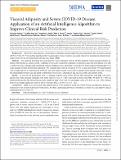Visceral Adiposity and Severe COVID-19 Disease: Application of an Artificial Intelligence Algorithm to Improve Clinical Risk Prediction
Author(s)
Goehler, Alexander; Hsu, Tzu Ming; Seiglie, Jacqueline A; Siedner, Mark J; Lo, Janet; Triant, Virginia; Hsu, John; Foulkes, Andrea; Bassett, Ingrid; Khorasani, Ramin; Wexler, Deborah J; Szolovits, Peter; Meigs, James B; Manne-Goehler, Jennifer; ... Show more Show less
DownloadPublished version (375.1Kb)
Publisher with Creative Commons License
Publisher with Creative Commons License
Creative Commons Attribution
Terms of use
Metadata
Show full item recordAbstract
Background: Obesity has been linked to severe clinical outcomes among people who are hospitalized with coronavirus disease 2019 (COVID-19). We tested the hypothesis that visceral adipose tissue (VAT) is associated with severe outcomes in patients hospitalized with COVID-19, independent of body mass index (BMI).
Methods: We analyzed data from the Massachusetts General Hospital COVID-19 Data Registry, which included patients admitted with polymerase chain reaction–confirmed severe acute respiratory syndrome coronavirus 2 infection from March 11 to May 4, 2020. We used a validated, fully automated artificial intelligence (AI) algorithm to quantify VAT from computed tomography (CT) scans during or before the hospital admission. VAT quantification took an average of 2 ± 0.5 seconds per patient. We dichotomized VAT as high and low at a threshold of ≥100 cm² and used Kaplan-Meier curves and Cox proportional hazards regression to assess the relationship between VAT and death or intubation over 28 days, adjusting for age, sex, race, BMI, and diabetes status.
Results: A total of 378 participants had CT imaging. Kaplan-Meier curves showed that participants with high VAT had a greater risk of the outcome compared with those with low VAT (P < .005), especially in those with BMI <30 kg/m2 (P < .005). In multivariable models, the adjusted hazard ratio (aHR) for high vs low VAT was unchanged (aHR, 1.97; 95% CI, 1.24–3.09), whereas BMI was no longer significant (aHR for obese vs normal BMI, 1.14; 95% CI, 0.71–1.82).
Conclusions: High VAT is associated with a greater risk of severe disease or death in COVID-19 and can offer more precise information to risk-stratify individuals beyond BMI. AI offers a promising approach to routinely ascertain VAT and improve clinical risk prediction in COVID-19.
Date issued
2021-05Department
Massachusetts Institute of Technology. Computer Science and Artificial Intelligence Laboratory; Massachusetts Institute of Technology. Department of Electrical Engineering and Computer ScienceJournal
Open Forum Infectious Diseases
Publisher
Oxford University Press (OUP)
Citation
Goehler, Alexander et al. "Visceral Adiposity and Severe COVID-19 Disease: Application of an Artificial Intelligence Algorithm to Improve Clinical Risk Prediction." Open Forum Infectious Diseases 8, 7 (May 2021): ofab275. © 2021 The Author(s)
Version: Final published version
ISSN
2328-8957